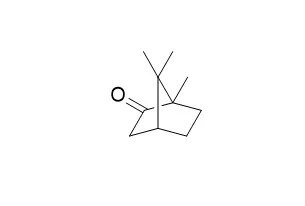| In vitro: |
| Journal of Chemical Ecology,1985,11:1297–1306. | | Isolation and identification of mosquito repellents inArtemisia vulgaris.[Reference: WebLink] | The mugwortArtemisia vulgaris L. (Compositae: Anthemideae) contains insect repellents which can be released from the plant tissues by combustion.
METHODS AND RESULTS:
Work was carried out to isolate and identify the repellent compounds. The dried, pulverized whole plants were steam-distilled to give a repellent essential oil which was fractionated by column chromatography. Active fractions were analyzed by capillary GC and by combined GC-MS. A number of compounds, mainly monoterpenoids, were identified. When tested as repellents against the yellow fever mosquitoAedes aegypti L. (Diptera: Culicidae), (±)-linalool, (±)-camphor((+/-)-Camphor), (+)-camphor, (−)-camphor, isoborneol, (−)-borneol, terpinen-4-ol, and isobornyl acetate were active at 0.14 mg/cm2 or higher. Nonanone-3, (α+β)-thujone, and bornyl acetate were active at 0.28 mg/cm2 or higher. β-Pinene, myrcene, α-terpinene, (+)− limonene, and cineole were active at 1.4 mg/cm2.
CONCLUSIONS:
Of the repellent compounds identified, terpinen-4-ol was the most active and was as effective as dimethyl phthalate. | | Mutat Res, 1998, 416(1-2):129-136. | | Mutagenicity testing of (±)-camphor, 1,8-cineole, citral, citronellal, (−)-menthol and terpineol with the Salmonella/microsome assay.[Reference: WebLink] | The essential oils and their monoterpenoid constituents have been widely used as fragrances in cosmetics, as flavouring food additives, as scenting agents in a variety of household products, as active ingredients in some old drugs, and as intermediates in the synthesis of perfume chemicals.
METHODS AND RESULTS:
The present study was undertaken to investigate the mutagenic potential of six monoterpenoid compounds: two aldehydes (citral and citronellal), a ketone ((+/-)-Camphor), an oxide (1,8-cineole, also known as eucalyptol), and two alcohols (terpineol and (−)-menthol). It is part of a more comprehensive toxicological screening of monoterpenes under way at our laboratory. Mutagenicity was evaluated by the Salmonella/microsome assay (TA97a, TA98, TA100 and TA102 tester strains), without and with addition of an extrinsic metabolic activation system (lyophilized rat liver S9 fraction induced by Aroclor 1254). In all cases, the upper limit of the dose interval tested was either the highest non-toxic dose or the lowest dose of the monoterpene toxic to TA100 strain in the preliminary toxicity test. No mutagenic effect was found with (+/-)-Camphor, citral, citronellal, 1,8-cineole, and (−)-menthol. Terpineol caused a slight but dose-related increase in the number of his revertants with TA102 tester strain both without and with addition of S9 mixture.
CONCLUSIONS:
The results from this study therefore suggest that, with the exception of terpineol, the monoterpenoid compounds tested are not mutagenic in the Ames test. |
|






 Cell. 2018 Jan 11;172(1-2):249-261.e12. doi: 10.1016/j.cell.2017.12.019.IF=36.216(2019)
Cell. 2018 Jan 11;172(1-2):249-261.e12. doi: 10.1016/j.cell.2017.12.019.IF=36.216(2019) Cell Metab. 2020 Mar 3;31(3):534-548.e5. doi: 10.1016/j.cmet.2020.01.002.IF=22.415(2019)
Cell Metab. 2020 Mar 3;31(3):534-548.e5. doi: 10.1016/j.cmet.2020.01.002.IF=22.415(2019) Mol Cell. 2017 Nov 16;68(4):673-685.e6. doi: 10.1016/j.molcel.2017.10.022.IF=14.548(2019)
Mol Cell. 2017 Nov 16;68(4):673-685.e6. doi: 10.1016/j.molcel.2017.10.022.IF=14.548(2019)